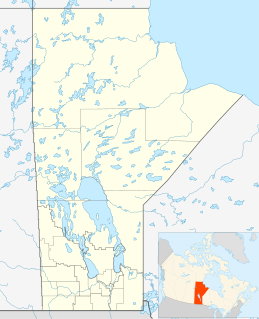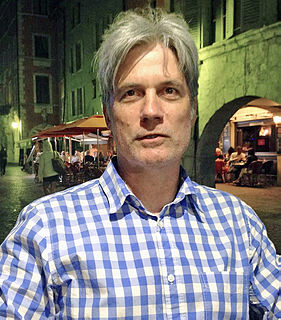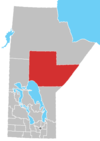
Gimli is a rural municipality located in the Interlake Region of south-central Manitoba, Canada, on the western shore of Lake Winnipeg. It is about 75 kilometres (47 mi) north of the provincial capital Winnipeg. The rural municipality's population in the Canada 2016 Census was 6,181.

The University of Winnipeg (UWinnipeg) is a public university in Winnipeg, Manitoba, Canada that offers undergraduate faculties of art, business and economics, education, science and kinesiology and applied health as well as graduate programs. UWinnipeg's founding colleges were Manitoba College and Wesley College, which merged to form United College in 1938. The University of Winnipeg was established in 1967 when United College received its charter. The governance was modeled on the provincial University of Toronto Act of 1906 which established a bicameral system of university government consisting of a senate (faculty), responsible for academic policy, and a board of governors (citizens) exercising exclusive control over financial policy and having formal authority in all other matters. The president, appointed by the board, was a link between the bodies to perform institutional leadership.

Ashern is an unincorporated community recognized as a local urban district located in the Rural Municipality of Siglunes in Manitoba's Interlake Region. The RM of Siglunes was incorporated in 1917. Ashern was named after A. S. Hern, a timekeeper of the firm that constructed the railway that served the Western Interlake.

St. Theresa Point is the largest and most populated of 3 reserves of St. Theresa Point First Nation. The Oji-Cree First Nation of 2,871 people is located in northern Manitoba, Canada on the southern shore of Island Lake, the sixth largest lake in the province.

Cordell Barker is a Canadian animator based in Winnipeg, Manitoba. He began animating in his late teens after taking on an apprenticeship at Kenn Perkins Animation. A two-time Academy Award nominee, Barker is an animation filmmaker with the National Film Board of Canada (NFB).

Sioux Narrows-Nestor Falls is a township in the Canadian province of Ontario, located in the Kenora District. It is located on the eastern shores of Lake of the Woods along Ontario Highway 71.
Shoal Lake 40 First Nation is an Ojibway or Ontario Saulteaux First Nation reserve located in the Eastman Region of Manitoba and the Kenora District of Ontario. The total registered population in September 2017 was 641, of which the on-reserve population was 285. The First Nation is a member of the Bimose Tribal Council, a Regional Chief's Council that is a member of the Grand Council of Treaty 3.

The Mathias Colomb First Nation, Mathias Colomb Cree Nation (MCCN), Mathias Colomb (Cree) First Nation, Pukatawagan/Mathias Colomb Cree Nation is a remote northern Manitoba First Nations, located 210 km (130 mi) north of The Pas and 819 km (509 mi) northwest of Winnipeg, Manitoba, which had two reserves under its jurisdiction, Indian Rreserve (IR) 198 and IR No. 199. They are part of the Treaty 6 and the main community is at Pukatawagan and consists of 1,536.6 ha on the shore of Pukatawagan Lake and lies about 210 km (130 mi) north of The Pas. Their second reserve was the Highrock reserve (CSD) located on Highrock Lake, 30 km (19 mi) downstream from Pukatawagan, which was dissolved by 2006.

God’s Lake First Nation is a First Nations band government whose reserve is primarily located at an area known as God’s Lake Narrows, about 250 kilometers southeast of Thompson, Manitoba. There are about 2,638 registered members of First Nation # 296. They are Swampy Cree, and more specifically, Rocky Cree (Asinīskāwiyiniwak). The First Nation is a member of the Keewatin Tribal Council.
Loc Dao is a Canadian digital media creator who is the chief digital officer (CDO) of the National Film Board of Canada. Dao was named CDO in March 2016, after serving as executive producer and creative technologist for the NFB English-language digital studio in Vancouver since 2011.

Gimli is a community in the Rural Municipality of Gimli on the west side of Lake Winnipeg in Manitoba. The community's first European settlers were Icelanders who were part of the New Iceland settlement in Manitoba. The community maintains a strong connection to Iceland and Icelandic culture today, including the annual Icelandic Festival. It was incorporated as a village on March 6, 1908, and held town status between December 31, 1946, and January 1, 2003, when it amalgamated with the RM of Gimli. Census Canada now recognizes the community as a population centre for census purposes. The 2016 Canadian census recorded a population of 2,246 in the urban centre of Gimli.
Bear 71 is a 2012 interactive National Film Board of Canada (NFB) web documentary by Leanne Allison and Jeremy Mendes about a grizzly bear in Banff National Park, who was collared at the age of three and was watched her whole life via trail cameras in the park. In March 2017, Bear 71 was re-released as a virtual reality work, viewable on Google Daydream and Google Cardboard.
KC Adams is a Canadian-born First Nations artist and art administrator.
Rob McLaughlin is a Canadian journalist and digital media producer who is currently the executive producer of the National Film Board of Canada's Digital Studio in Vancouver. McLaughlin was announced as the head of the NFB studio in May 2016, having previously served as Director of Digital Content and Strategy at the NFB from 2008–2011. McLaughlin replaces Loc Dao, who was appointed the NFB's chief digital officer in March 2016.
Way to Go is a 2015 Canada/France interactive film and virtual reality web-based experience created by the Montreal digital studio AATOAA and produced by National Film Board of Canada and France Télévisions. The production lets users take a virtual walk in the woods, through a combination of animation and immersive video.
God's Lake Narrows is an interactive visual essay, written and directed by Kevin Lee Burton, co-created with Alicia Smith, sound design by Christine Fellows, and photography by Manitoba-based Anishinabe artist Scott Benesiinaabandan. The visual essay is hosted online by the National Film Board of Canada and was funded in partnership with imagineNATIVE Digital Media Partnership.
This River is a 2016 Canadian short documentary film directed by Katherena Vermette and Erika MacPherson. The film centres on Drag the Red, a volunteer group in Manitoba who search the Red River for the bodies of Missing and Murdered Indigenous Women.















